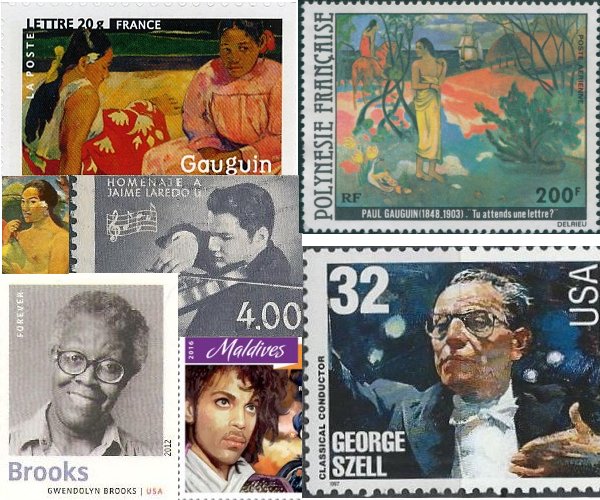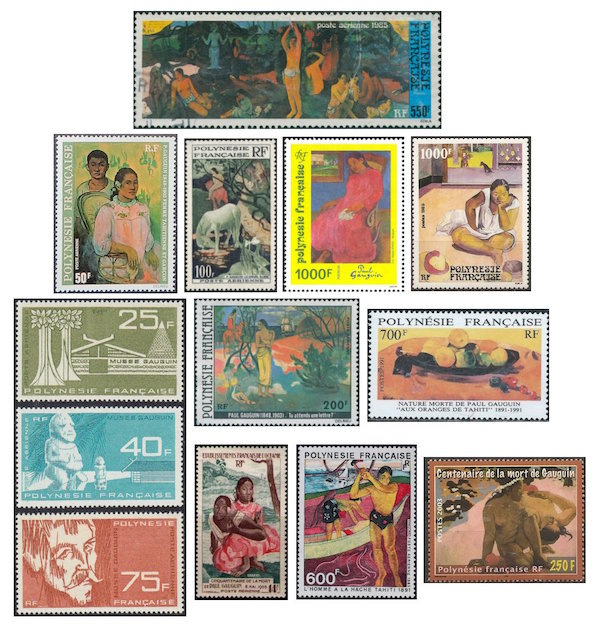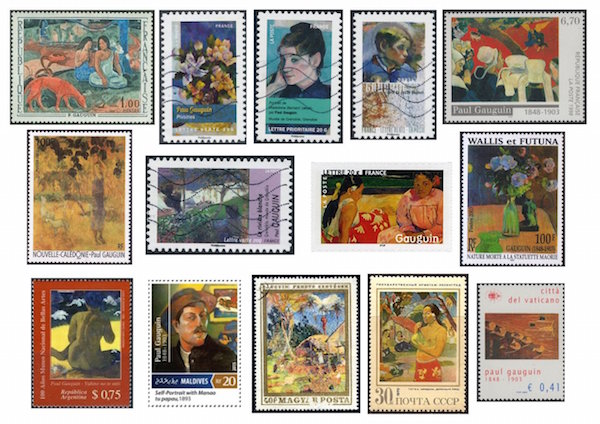The Arts on the Stamps of the World — June 7
An Arts Fuse regular feature: the arts on stamps of the world.

By Doug Briscoe
We have two centenaries to mark today, along with the birthdays of Paul Gauguin, George Szell, and several others.
Born in Topeka, Kansas one hundred years ago today was American poet Gwendolyn Brooks (June 7, 1917 – December 3, 2000). Her father had hoped to be a doctor but gave up the pursuit to start a family, and her mother was a teacher and classically trained pianist. They took baby Gwendolyn to Chicago when she was only six weeks old. She published a poem in a children’s magazine when she was 13 and while still in her teens contributed to the Chicago Defender, earning praise from such writers as Langston Hughes and Richard Wright, who recommended her first poetry collection, A Street in Bronzeville (1945), for publication. Her second book, Annie Allen (1949), was awarded the 1950 Pulitzer Prize for Poetry, the first to be awarded to an African American. Besides her poems, she wrote a novella, Maud Martha, and two volumes of autobiography. Gwendolyn Brooks was one of ten American poets honored on a sheet of stamps issued in 2012.
Also born on this day a hundred years ago was Dean Martin (né Dino Paul Crocetti; June 7, 1917 – December 25, 1995). His birthplace was Steubenville, Ohio, and he spoke no English before going to elementary school. On the stamp from Ghana (on which the likeness, I must say, is not very flattering), he is paired with his longtime professional partner Jerry Lewis.

Despite the above centennial notices, the superstar of June 7th is Paul Gauguin (1848 – 8 May 1903), to whom I give two collages all to himself. (We’ll return to Collage #1 in a bit.) Gauguin’s family had interests in Peru, and he lived there from ages two to six, a happy period that inculcated in Paul’s mind the fixed idea of a tropical paradise. We’ll return to this in a moment. Back in France, Gauguin served in the navy and became a successful stockbroker until the Paris stock market crash of 1882. He had taken up painting in his spare time and now decided to become a full-time artist. A failed business venture in Copenhagen only stiffened his resolve. On the way back from an 1887 visit to Panama he spent six months on the island of Martinique. On his return to France he formed associations with Vincent Van Gogh and Edgar Degas, but the lure of the tropics called Gauguin to Tahiti in 1891, to which, separated from his family, he returned in 1895, where he spent six years before moving on to the Marquesas, and there he lived out his last two years. The world’s Gauguin stamps are as teeming and profuse as a Tahitian landscape. Many of them have been issued under the auspices of the postal service of French Polynesia, including the one I place at the top, Where Do We Come From? What Are We? Where Are We Going? (1897), which Gauguin regarded as his masterpiece and which can be seen at Boston’s very own Museum of Fine Arts. All the remaining stamps in this collage are from French Polynesia, with at bottom left a set of three commemorating the Paul Gauguin Museum in Tahiti. Next to them in the bottom row is what I believe to be the world’s oldest Gauguin stamp, dated 1953, the painter’s Nafea faa ipoipo (When Will You Marry?, 1892). The next collage begins with stamps of France, some of them reflecting Gauguin’s pre-Pacific œuvre, with, in the second row, a couple of stamps from other French Pacific possessions: New Caledonia and Wallis and Futuna. Finally, in the bottom row, are found Gauguin stamps from other countries: Argentina, the Maldives, Hungary, Russia, and Vatican City.
Back to the first collage for our next offerings. As the author of the Wikipedia article on conductor George Szell (1897 – July 30, 1970) eloquently puts it, “Through his recordings, Szell has remained a presence in the classical music world long after his death, and his name remains synonymous with that of the Cleveland Orchestra”, which he is credited with having built into one of the world’s greatest. A later music director, Christoph von Dohnányi, wittily remarked, “We give a great concert, and George Szell gets a great review.” Born György Széll in Hungary, he studied briefly with Max Reger and was active in his youth as a composer and pianist. (In later years he made a small number of superior recordings playing piano in chamber works.) He settled in the US in 1939 and led the Cleveland Orchestra from 1946 to his death in 1970. Even today, some of his many recordings are among my favorite interpretations.

The Scottish architect Charles Rennie Mackintosh (7 June 1868 – 10 December 1928) is remembered with a British stamp showing perhaps his most celebrated building, the Glasgow School of Art (1897–1909). (The school suffered great damage in a fire in 2014 and is now being restored.) As designers, he and his wife Margaret Macdonald exerted considerable influence on European Art Nouveau and Secessionism. With her sister Frances MacDonald and Frances’ husband Herbert MacNair the quartet became known as “The Glasgow Four”. Besides architecture and design, Mackintosh also worked in furniture, textiles, and metalwork. After relocating to Suffolk in 1914, Mackintosh was thought to be a German spy and was briefly incarcerated in 1915. Following World War I they moved to the south of France.
Tenor Leonid Sobinov (June 7, 1872 [OS May 26] – October 14, 1934) was a great favorite in both Imperial and Soviet Russia, though his elder son Yuri had been killed in 1920 fighting against the Bolsheviks. Outside the Russian repertoire Leonid Sobinov performed in Wagner, Verdi, Gounod, and Massenet at La Scala in 1904-06 and 1911. Most of his many recordings were made before 1917.
I used to think Jaime Laredo was a native American, but he was born in Bolivia and came to North America at the age of seven in 1948. Here he studied under Josef Gingold, among others. After he won the 1959 Queen Elizabeth of Belgium Competition the Bolivian nation, proud of her native son, issued a series of stamps in his honor (1960). I show a couple of examples from the series. Both his marriages were to very distinguished musicians: pianist Ruth Laredo (from 1960 to 1974) and cellist Sharon Robinson (since 1977). Laredo has been music director of the Vermont Symphony since the year 2000.

Also born on June 7 was the Cuban flutist Roberto Ondina (1904 – July 1, 1963), who was playing the instrument in silent movie theaters and dance bands from the age of 12. Later he joined the Havana Symphony Orchestra and was a founding member of the National Symphony Orchestra. Ondina’s playing was highly praised by such great figures as Erich Kleiber (“a virtuoso…impeccable…a great flautist”) and Igor Stravinsky, yet, a modest man, he never sought the limelight as a soloist and rarely performed abroad. Ondina was also much admired as a teacher. He died during a television broadcast of the National Symphony. His stamp is one of a set of five honoring members of the Havana Philharmonic for its 50th anniversary.
Happy 65th birthday to celebrated actor Liam Neeson. He was born in Northern Ireland and reared Roman Catholic, so perhaps it’s not surprising that he took up boxing at the age of nine, eventually becoming amateur senior boxing champion of Ulster. (Curiously, both Dean Martin and Paul Gauguin had also practiced the manly art.) Neeson studied physics and computer science and was involved with Helen Mirren and later married to the fine actress Natasha Richardson, who died after a skiing accident in 2009. It was in that year, too, that Neeson became an American citizen. He is on stamps because of the Star Wars phenomenon; he played the Jedi master Qui-Gon Jinn in Star Wars: Episode I – The Phantom Menace (1999).
A handsome sheet of four stamps from the Maldive Islands honors the late Prince Rogers Nelson (June 7, 1958 – April 21, 2016), the gifted American singer-songwriter and multi-instrumentalist who died last year of an accidental fentanyl overdose.
Faroese artist Anker Eli Petersen (born 7 June 1959) has designed a number of Faroe Islands postage stamps, often dealing with Norse mythology, as in the pair depicting Thor and the sea goddess Rán. The block of four honors the Faroese linguist, scholar, and ethnographer Jens Christian Svabo (1746 – 1824). Petersen, who goes by the professional name Anker Eli, has also illustrated books and written song lyrics.
Deserving of a stamp is the superb Irish fiction writer Elizabeth Bowen (7 June 1899 – 22 February 1973), and we wish a happy birthday to American film director James Ivory (born 1928), of Merchant/Ivory fame, and 2006 Nobel Prize winner Ferit Orhan Pamuk (born 1952), a Turkish novelist, screenwriter, and academic.
A graduate of the University of Massachusetts with a B.A. in English, Doug Briscoe worked in Boston classical music radio, at WCRB, WGBH, and WBUR, for about 25 years, beginning in 1977. He has the curious distinction of having succeeded Robert J. Lurtsema twice, first as host of WGBH’s weekday morning classical music program in 1993, then as host of the weekend program when Robert J.’s health failed in 2000. Doug also wrote liner notes for several of the late Gunther Schuller’s GM Recordings releases as well as program notes for the Boston Classical Orchestra. For the past few years he’s been posting a Facebook “blog” of classical music on stamps of the world, which has now been expanded to encompass all the arts for The Arts Fuse.
